
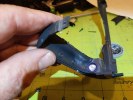
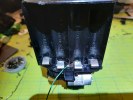
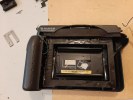
This will require one Instax wide camera and one metal bodied Polaroid pack film camera. The Polaroid camera should have the extra exposure settings which allows it to be set for 300 ASA, so that metering with Instax film is possible. It may be possible to use any camera by setting it to 3000 ASA and using a 2 (or 3) stop ND filter over the electric eye. I found that exposing with the 300 ASA setting is pretty close since these cameras are getting old and often need exposure compensation of 1 mark toward lighten anyway because of the aging electric eye. Or, you can convert this camera to manual shutter capability. An overview of the upside down conversion is described in this video. An overview of preparing an Instax 100 to be used as a back is shown in this video.
You can mount the Instax wide back upside down or right side up. Regardless of the method, you will need to start by getting the Instax wide camera ready to use as a back.
This operation involves taking the Instax camera apart and removing the electronic guts, leaving just the motor, gears, and rollers. If using an Instax 100, the lens body needs to be cut off with a hacksaw blade or other tool. The lens body on a 210 is not attached to the back, so won't need to be cut off. Because motor run-on is a problem with Instax wide drivetrains, previous instructions detailed reducing the time the cycle switch is on. New instructions on how to wire the back with a relay which prevents run-on is detailed below.
A 6v relay is used to prevent motor run-on which will eject the whole pack of film if the cycle switch is wired in series with the battery. The relay shorts out the motor when turned off, instantly stopping it.
| Wire the back according to the wiring diagram below, using a 6 volt relay using the schematic provided here | 
|
| The carbon dot under the rubber shutter on an Instax 100 is replaced with a piece of aluminum foil for a better contact. The Instax 210 has a microswitch for a shutter button and needs no modification. | 
|
| Solder a wire onto the appropriate battery terminal depending on the voltage requirement of the camera. Check the comparison chart to see what voltage your camera needs. Run this and the negative wire outside the camera. | 
|
| Attach the back of the Instax case to the back and run the battery leads to the front. Place a piece of craft foam over the rollers protruding down so it clamps against the camera when mounted to prevent light leaks. | 
|
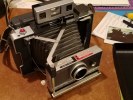
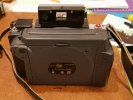
This conversion is easier to do but winds up being thicker (around 15mm) than the upside down conversion. It also requires access to a 3d printer, but it doesn't require any cutting of the Polaroid frame. It also retains the use of the tripod socket. You will need to get and print the 3d files for this conversion since it needs various pieces to complete it. You will also need a single AA battery holder, some wire, solder iron, a momentary switch for the eject button, and some small screws as well as basic tools.
This is a more difficult conversion since it requires extensive cutting to the camera frame. This will make the camera more compact, but the tripod socket won't be available.
Counting the exposures can be done with a piece of paper with 10 tabs cut into it, taped onto the back or inside the case. One tab is ripped off when a photo is ejected.
There you have it! A Pola Instax camera in 33 easy steps! Contact me if you'd have questions or would like to share your build.